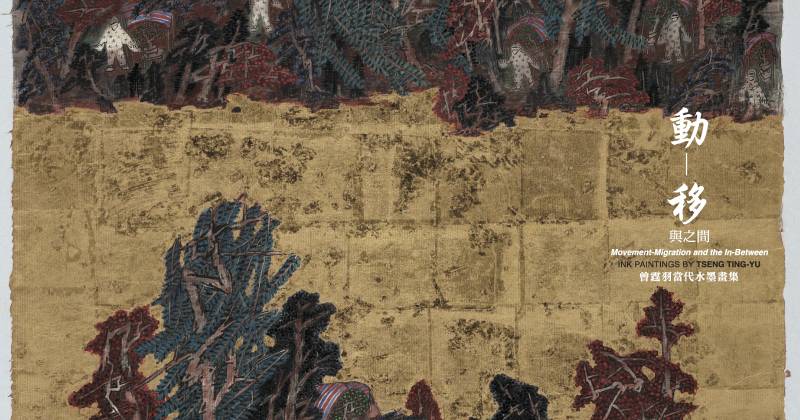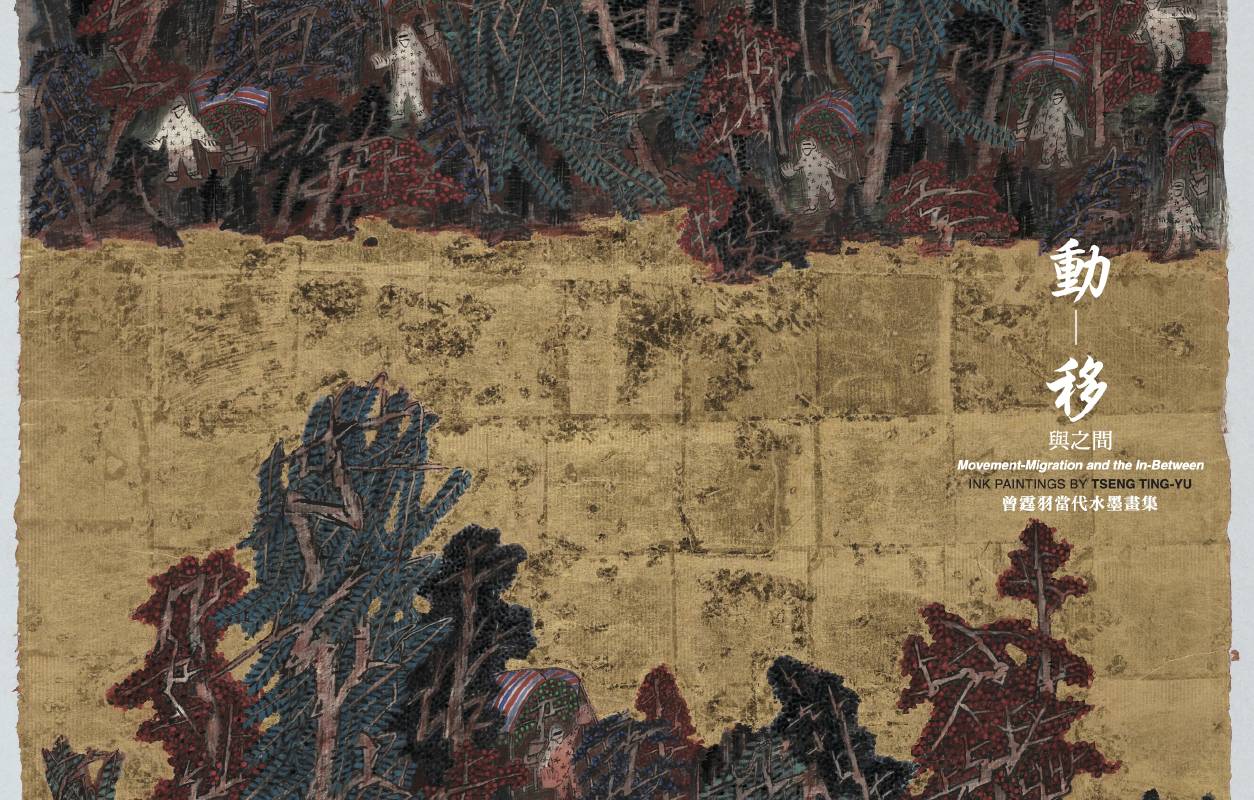紫藤廬
【《動—移 與之間》 Movement-Migration and the In-Between】曾霆羽當代水墨個展 Contemporary Ink Painting By Tseng Ting-yu

-
展期
日期:2022-03-12 ~ 2022-04-24
-
地點
紫藤廬
-
相關連結
-
參展藝術家
曾霆羽
-
紫藤廬於2022年特別邀請甫於2021歲末獲得第二屆香港水墨會「劉國松水墨藝術大獎」的曾霆羽,此次預備展出《動—移 與之間》當代水墨展。
曾霆羽現任職於山東理工大學美術學院,創作歷程從 2008 年研究所起算至今近十三年,這段時間的浸漬,思考「自身」、「水墨」和「土地」之間的關係。2018 年臺灣師範大學美術系博班畢業後,因緣際會到山東理工大學任教至今的經歷,讓他有機會從熟悉的場域抽離,能以他者的角度重新審視、觀照這三者之間的關係。在這樣的思考過程中,可以清晰地看到自己可以再前進的空間,也可以看見擁有及值得守護珍惜的一切,進一步思考「台灣水墨」的發展可能……
近年來曾霆羽往返故鄉和異鄉的反覆切換,亦遙想起早年一批渡海來台的前輩畫家,如渡海三家等,物換星移回望自身,不禁有此渡海非彼渡海之感觸,遂在《貳壹老梗》系列中擬仿倪雲林「一水兩岸」之構圖,投射自身移動經驗及整個大時空的社會氛圍,其中以純金箔作為分隔兩岸的水,金箔的貴重顯眼及在視覺上的強度與份量,象徵著兩岸對於一水之隔的彼此,都有著複雜且巨量的情緒與想像。
曾霆羽更以「觀念」、「水」和「墨」做為創作形式,並以中國特有的「散點透視」來思考抽換人的座標,結合移動的視角,切入己身和他方及大時代敘事想像。早期畢卡索和杜象在發展立體派時機動藝術的前期,同時期的藝術家也都在思考,如何記錄下時間和移動,觀察者的位移又如何同時呈現在一個畫面上(如杜象-下樓梯的女人)。從這樣的角度來觀看曾霆羽的同步正在進行間,並帶有移動、搜尋、定位的作品,有異曲同功之妙。
帶著濃厚詩意的曾霆羽,家、土地和身份認同、角色切換,都一一將它溶入於水墨之間,而最終那移動的焦點卻落在茫茫的水中。透過這樣的梳理,「水」在曾霆羽是一個有趣的「間距」,像帶著望遠鏡的探險者,遊移於二個「邊界」,作品便是「邊際效應」共震後的產物。「一水兩岸」淘金夢,也同時突顯出夢想和現實中,掙扎、沉浮和追逐的超現實情境。
「墨」是曾霆羽影像和空間裝置的主要媒材,2015年應中華文化總會邀請,於當年的「漢字藝術節」製作一件帶有漢字元素的空間裝置作品,於是有了〈象棋〉這件作品。作品中主要挪用「象棋」之概念,並以「離開水墨繪畫之水墨」概念作為詮釋。「象棋」作為華人文化中的經典益智遊戲,常見於公園等公共場域,同時象棋對弈過程主要是仰賴漢字符號的溝通,因此作品中將象棋的其中一方文字改為簡體字,形成繁體字和簡體字兩大陣營,並將其刻於自製的墨碇上,依此象徵兩岸目前狀態,即在一種同源文化(漢文化)中,一水兩岸的楚河漢界,發展出兩個不同的政治實體,同時以大理石製作棋盤(硯台),並將棋盤上楚河漢界和棋盤格線之部分挖深形成蓄水墨池,也就是說在對弈過程中,象棋(墨碇)在楚河漢界(墨池) 來來去去之間,則會形成一種磨墨的效果,因此也會在棋盤上留下對弈的痕跡。於展覽期間邀請大陸人和台灣人分邊代表各自的一方進行對弈,並以影像記錄整個過程。
2021《老梗戲墨》取材自北宋蘇軾提出「墨戲」,著重文人水墨繪畫的情懷及筆墨的氣韻生動,而今老梗挪用「戲墨」二字,則是帶著遊戲的心情,將水墨從平面繪畫的形式中鬆脫出來,並試圖在調動筆墨紙硯既有的複合關係中,揭示生活的現實與荒謬。以渡海來台的前輩畫家劉延濤所言:「客居漸久漸能安,閒認白雲作雪看。」作為此創作階段的歷史呼應,時空輪轉的此刻,客居山東的曾霆羽則有『閒認白雪』做『雲』看」之感。
曾霆羽提出了一個有趣的「間距」,我們遊移於「動—移 與之間」,身於何處?彼岸又於何處?與紫藤廬一同來漫游墨中山水,探索彼岸……
Movement-Migration and the In-Between: Tseng Ting-yu Contemporary Ink Exhibition
For Wistaria’s first solo exhibition of 2022, Movement-Migration and the In-Between, we are honored to invite Tseng Ting-yu, the 2021 recipient of Hong Kong’s prestigious Liu Kuo-sung Ink Art Award - Honourable Mention, to display his award-winning works, as well as some of his new pieces, for the first time in Taiwan.
Since 2008, Tseng has contemplated, through both philosophy and art, the intricate relationship between the self, ink painting, and place. In 2018, upon the completion of his art degree from the National Taiwan Normal University, Tseng began teaching at the Shandong Institute of Technology, where his status as an “other” inspired him to observe and rethink the interplay of the individual, art, and geography. This process proved to be central in the artist’s thinking of “Taiwanese ink painting,” whose creative and innovative potential must be derived from the balance between history and futurity.
In recent years, Tseng’s constant movement to and from home and abroad recalls the migration of the previous generation of Taiwanese artists, such as the notable “Three Masters who Crossed the Sea”: Zhang Daqian, Huang Junbi, and Pu Ru.
Tseng’s artistic approach utilizes the interplay of concept, water, and ink with a unique characteristic of Chinese painting, the multi-point perspective, to examine the fluctuations of the self and the other. The shifting viewpoints that arise from this approach are critical to the artist’s imagining of the complex nexus of the self, place, and time. In a sense, Tseng’s work shares the same philosophical and visual concerns of early Cubist painters such as Pablo Picasso and Marcel Duchamp: a heartfelt attempt to visually represent movement through time, while reflecting on the canvas the simultaneous shifts in the viewer’s perspective (an instructive example would be Duchamp’s Nude Descending a Staircase). In this context, Tseng’s oeuvres convey, albeit through a different visual vocabulary, the notions of simultaneity and ongoingness, as well as the themes of movement, exploration and fixity.
Tseng’s ink painting explores the fluidity of home and land (home/land), self and identity (self-identity). Poetically, this fluidity is evoked by the artist’s decision to locate the vanishing points in water: fluidity in water. For Tseng, water symbolizes the state of in-betweenness, of ongoingness, like a telescope-wielding explorer moving from frontier to frontier. Furthermore, for Tseng water also characterizes the inherent contradiction of art: that art is a product of marginal utility. This concept can be inferred from the phrase “one straits, two shores,” an expression used to describe one’s pursuit of wealth within the economic, political, and cultural context of cross-straits relations. Ultimately, “one straits, two shores” signifies the surrealness of the clash between dreams and reality: the waves propel the explorer forward, but can also drown him/her.
Tseng’s digital and installation art utilizes ink as the principal medium. This practice was first conceived in 2015, when the artist was invited by the General Assocation of Chinese Culture to submit a piece for the “2015 Culture Art Festival for Chinese Characters.” Xiangqi (Chinese Chess), was thus created as a work that executed the concept “ink away from ink painting,” as an installation that played on the board game’s calligraphic and public characteristics. A classic Chinese game of intellect that is often played in public spaces – parks, for instance – it differs many other traditional board games in its use of the written word to represent playing pieces. Poignantly, Tseng decides to cast the two sets of pieces in different scripts, Traditional and Simplified Chinese, to capture the current state of cross-straits relations: even though both sides share the same ancestral Sinic culture, they, like the chess pieces, are divided by a body of water demarcating differences in political systems.
In Xiangqi, each component corresponds to an item in Chinese calligraphy: the board to the ink-stone, the pieces to the inksticks, and the river to the inkwell. As the audience plays against one another on this set, the movement of the pieces will leave marks on the board, mimicking the friction of inksticks on ink-stone. Previous exhibitions of this installation pitted Chinese and Taiwanese visitors against one another, encounters which the artist has recorded and which are now on display in Movement-Migration and the In-Between. Similarly, Revival: Play with Ink is inspired by moxi, an idea popularized by the renowned Song Chinese literati Su Shi. Literally meaning “play with ink,” moxi is the liberation of art from formal and formulaic practices through play and playfulness. Tseng’s Revival: Play with Ink, then, plays on the relationship between ink, paper, and ink-stone to illuminate the realities and absurdities of life.
“A guest who stays for a long time will eventually see the clouds for snow,” strikes Tseng as a fitting expression for this moment in history. Attributed to Liu Yantao, a Chinese artist hailing from the generation “who crossed the straits” to Taiwan, the phrase underscores the manner in which the self, culture, and geography interact: slowly, vestiges of the past, of home, begin to manifest in one’s view of the present. For Tseng, who moved across the straits to Shandong, he is a “guest” who sees “the snow for clouds.” Home is in the eye of the beholder.
In this context, in-betweenness is Tseng Ting-yu’s response to the increasingly globalized and mobile character of the world. Movement-Migration and the In-Between highlights encourages a playful exploration of the fluidities of self, place, and time. Where are we born? What lies on the other shore? Discover for yourself at Wistaria Tea House this spring.
-
REFERENCE
推薦展覽
view all宛儒畫廊
【地衣 - 黃碧惠當代水墨創作展】Lichen - Pi-Hui Huang Contemporary Ink Painting Exhibition
日期:2024-11-10 ~ 2024-12-31|台灣,台北市
16 days left